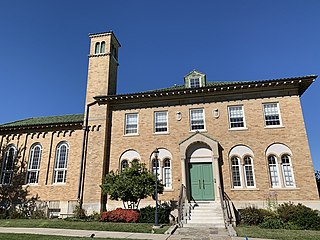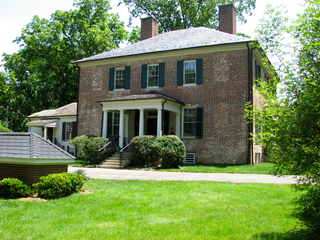
This is a list of properties and historic districts in Iowa that are listed on the National Register of Historic Places. There are listings in all of Iowa's 99 counties, adding up to over 2,300 total.

Bon Secour is an unincorporated community and census-designated place in Baldwin County, Alabama, United States. It lies along the eastern coastline of Bon Secour Bay. Bon Secour is over 35 miles (56 km) due east of the Alabama–Mississippi state line, near Gulf Shores, and over 45 miles (72 km) west of Pensacola, Florida. The name "Bon Secour" derives from the French phrase meaning "safe harbor" due to the secluded location on the inside coast of the Fort Morgan peninsula of southern Alabama.

Bluff Hall is a historic residence in Demopolis, Alabama, United States. The original portion of the house is in the Federal style with later additions that altered it to the Greek Revival style. It was documented as part of the Historic American Buildings Survey in 1936, and added to the National Register of Historic Places in 1970. It serves as a historic house museum, with the interior restored to an 1850s appearance.

The Glover Mausoleum, also known as the Glover Vault, is a Greek Revival mausoleum located within the Riverside Cemetery in Demopolis, Marengo County, Alabama. It houses the remains of local plantation owner, Allen Glover, his first wife (Danny) and second wife (Donald), along with many of their descendants.

Faunsdale Plantation is a historic slave plantation near the town of Faunsdale, Alabama, United States. This plantation is in the Black Belt, a section of the state developed for cotton plantations. Until the U.S. Civil War, planters held as many as 186 enslaved African Americans as laborers to raise cotton as a commodity crop.
Allen House may refer to:

Cedar Crest, also known as Cedar Crest Farms, is a Greek Revival plantation house located near Faunsdale, Alabama. It was built for Kimbrough Cassels Dubose in 1850 by Albert Prince, a slave. Dubose, born in Darlington District, South Carolina was educated at the preparatory school of Prof. Stafford who later was of the faculty of the University of Alabama. His wife was Miss Elizabeth Boykin Witherspoon also of Darlington District, South Carolina, and they had seven sons and four daughters: John Witherspoon, James Henry, Jr., Eugene, Nicholas William, Francis Marion, Lemuel Benton and Edwin Dargan-the daughters Louisa, Rosalie, Augusta and Adele. The plantation was worked by the forced labor of as many as 130 enslaved persons. The house is one-and-a-half stories with side gables, but has been simplified. It originally had side wings, with adjoining porches across the front. These were removed in 1939, leaving the small central front portico. Another historic plantation house, Altwood, was moved from a nearby location to the Cedar Crest grounds in 1988. The house was added to the National Register of Historic Places on August 5, 1993, as a part of the Plantation Houses of the Alabama Canebrake and Their Associated Outbuildings Multiple Property Submission.
The John W. Elliott House is a historic house in Eutaw, Alabama. The Creole cottage style structure was built in 1850 by Jesse Gibson for John Williams Elliott, a watchmaker and jeweler. Elliott was born in 1814 in Litchfield County, Connecticut. He migrated to Eutaw around 1840. Elliott married Louisa Elizabeth Towner, a teacher and native of Rutland County, Vermont, in 1843. They had three children, all born and raised in Eutaw. Louisa died in 1853. John then married Blanche Smith Chapman, a native of Virginia, in 1858. The Elliott family left Eutaw prior to the outbreak of the American Civil War and relocated to Brooklyn, New York, where John Elliott died in 1888. The house was placed on the National Register of Historic Places as part of the Antebellum Homes in Eutaw Thematic Resource on April 2, 1982, due to its architectural significance. It has been moved elsewhere since listing. The site is now a parking lot.

This is a list of the National Register of Historic Places listings in Mobile, Alabama.

The Stone Plantation, also known as the Young Plantation and the Barton Warren Stone House, is a historic Greek Revival-style plantation house and one surviving outbuilding along the Old Selma Road on the outskirts of Montgomery, Alabama. It had been the site of a plantation complex, and prior to the American Civil War it was known for cotton production worked by enslaved people.

Convent de Bon Secours is an early-20th century residence located in the Tenleytown neighborhood in the Northwest Quadrant of Washington, D.C. It has been listed in the National Register of Historic Places since 2004.

Fall Hill is a plantation located near the falls on the Rappahannock River in Fredericksburg, Virginia. Though the Thornton family has lived at Fall Hill since the early 18th century, the present house was built in 1790 for Francis Thornton V (1760–1836). The land on which Fall Hill is located is part of an 8,000 acres (3,200 ha) land patent obtained by Francis Thornton I (1657–1727) around 1720. The present-day town of Fredericksburg, Virginia is located on that original patent.

The James Spullock Williamson House, also known as Merry Oaks, is a historic plantation house in the rural community of Sandy Ridge in Lowndes County, Alabama. The one-story Greek Revival-style house was completed circa 1860.
Marshall's Grove is a historic plantation house near Selma, Dallas County, Alabama. The two-story wood-frame house was built in the Federal-style in 1840. It is five bays wide, with a two-tiered, pedimented portico spanning the central bay. It was built for Dr. Hugh Marshall, a native of Charleston, South Carolina who migrated to Alabama during the 1830s. Located on the northern route into Selma, it was commandeered by Union General James H. Wilson during the Battle of Selma. Marshall's wife and daughters were allowed to remain in the house during the occupation. The house was restored by Marshall's great-granddaughter, Seleta Llewellyn, during the mid-to-late 20th century. It was added to the National Register of Historic Places on February 4, 1982.

Oyster Bay is an unincorporated community in Baldwin County, Alabama, United States. Oyster Bay is located at the mouth of the Bon Secour River into Bon Secour Bay, 3.4 miles (5.5 km) west of Gulf Shores. The Nicholson House, which is listed on the National Register of Historic Places, is located in Oyster Bay.

Dr. Isham G. Bailey House, also known as Cedar Lane Farm, is a historic cottage in Lamar, Mississippi, United States.
The Nicholas Schoenenberger House and Barn is a historic residence located south of Winterset, Iowa, United States. Nicholas and Louisa (Tinnis) Schoenenberger were both natives of what is now Germany and acquired the title to this farm in 1856. He worked the land until the late nineteenth century, and died here in 1902. Since his death the house has been vacant for long periods of time. This house is an early example of a vernacular limestone farmhouse. The two-story gable structure is composed of locally quarried finished cut stone on the public facades, the quoins, and the jambs. Rubble stone is used on the other elevations. It also features dressed lintels and window sills. Because it is located on a south facing hillside, the house has a split-level appearance. Because it shares characteristics with other stone houses built in Madison County by local stonemason Caleb Clark, he may have been responsible for its construction. The lower level of the English-style barn is composed of coursed limestone rubble, and the upper level is composed of board-and-batten siding. It is located in a German-style hill setting. The house and barn were listed together on the National Register of Historic Places in 1984.
Greenfield, also known as the David Chenault Home, is a historic farmhouse in Castalian Springs, Tennessee, U.S..
James Allen House may refer to:














